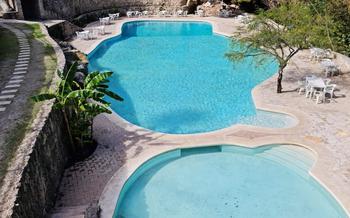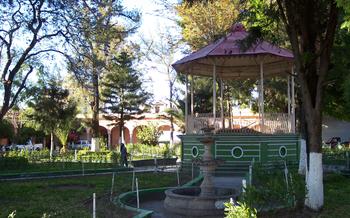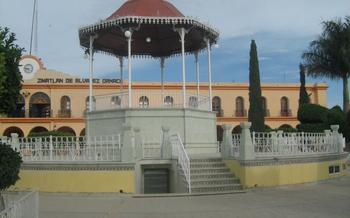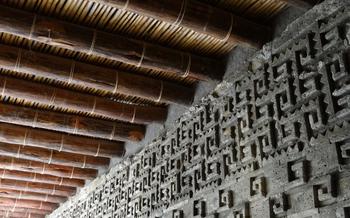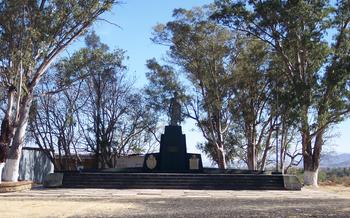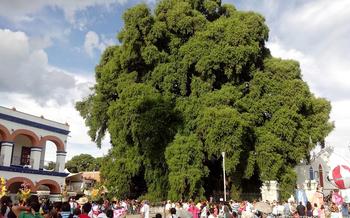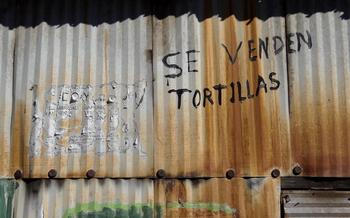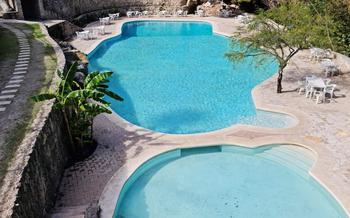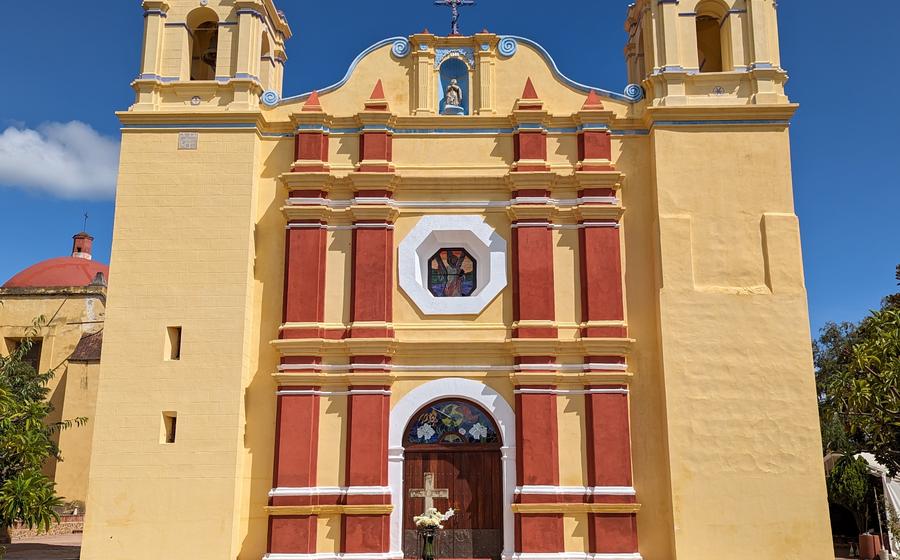
San Andrés Huayapam
- Exploring San Andrés Huayapam: A Zapotec Village
- Immerse in Zapotec Culture
- Visit the Templo de San Andrés
- Marvel at the Templo de las Siete Generaciones
- Stroll through the Mercado de Artesanías
- Discover the Museo Comunitario de San Andrés Huayapam
- Attend the Guelaguetza Festival
- Enjoy Zapotec Cuisine
- Learn about Zapotec Weaving
- Museo Textil de Oaxaca: A Showcase of Zapotec Weaving
- Explore the Surroundings
- Engage with the Local Community
- Learn Some Zapotec Phrases
- Insider Tip: Unveiling Hidden Gems and Local Delights
Exploring San Andrés Huayapam: A Zapotec Village
Nestled in the lush valleys of Oaxaca, Mexico, lies the charming village of San Andrés Huayapam, a vibrant testament to the rich cultural heritage of the Zapotec people. Founded in the 16th century, the village has preserved its distinctive identity and traditions, offering visitors a unique glimpse into the heart of Zapotec culture.
San Andrés Huayapam is renowned for its well-preserved colonial architecture, colorful markets, and breathtaking natural surroundings. The village is easily accessible by road, making it a popular destination for day trips from Oaxaca City. The best time to visit is during the Guelaguetza Festival, held annually in July, when the village comes alive with vibrant performances, traditional dances, and music.
Immerse in Zapotec Culture
The Zapotec people, with their rich cultural heritage, warmly welcome visitors to San Andrés Huayapam. Their traditions and customs are deeply rooted in their history, shaping their way of life. The Zapotec language, still spoken by many in the community, holds significant importance, connecting them to their ancestors and preserving their unique identity.
Traditional attire plays a vital role in Zapotec culture. Women often wear colorful blouses, known as "huipiles," intricately embroidered with floral and geometric patterns. These garments showcase their artistic skills and serve as a symbol of their cultural pride. Men typically wear white cotton shirts and pants, complemented by a woven sash known as a "ceñidor."
Zapotec cuisine is a culinary delight, offering a diverse range of flavors and textures. Must-try dishes include "tlayudas," large tortillas topped with beans, cheese, meat, and vegetables, and "tamales," steamed corn dough parcels filled with various fillings. "Mole negro," a complex sauce made with over 20 ingredients, is a culinary masterpiece not to be missed.
Local markets, such as the Mercado de Artesanías, are a vibrant hub of activity, where Zapotec artisans display their handcrafted goods. Visitors can find an array of textiles, pottery, jewelry, and other unique items, each telling a story of Zapotec craftsmanship and creativity.
Zapotec rituals and ceremonies hold deep spiritual significance, connecting the community with their ancestors and the natural world. These events, often accompanied by music, dance, and offerings, provide a glimpse into the Zapotec belief system and their reverence for tradition.
Visit the Templo de San Andrés
Constructed in the mid-16th century, the Templo de San Andrés stands as a testament to the fusion of indigenous and Spanish influences in the region. This Dominican church, a symbol of the Spanish colonial era, boasts an impressive facade adorned with intricate stone carvings depicting biblical scenes, saints, and mythical creatures. The interior of the church is equally captivating, with its vaulted ceilings, elegant arches, and vibrant murals showcasing the artistic prowess of the Zapotec people.
Architectural Beauty and Historical Significance
The Templo de San Andrés, a prime example of colonial architecture, seamlessly blends Renaissance and Baroque elements. Its facade is a masterpiece of indigenous artistry, adorned with intricate carvings that narrate the arrival of the Spanish and the subsequent evangelization of the Zapotec people. Inside, the church is a treasure trove of religious art, featuring stunning murals that depict biblical scenes and Zapotec mythology.
Murals and Religious Festivals
The church's murals are particularly noteworthy, as they showcase the unique blend of Spanish and Zapotec artistic traditions. These vibrant paintings depict scenes from the Bible, such as the Creation and the Last Supper, alongside images of Zapotec deities and cultural symbols. The church also serves as a venue for religious festivals throughout the year, where the Zapotec community gathers to celebrate their faith and cultural traditions.
Marvel at the Templo de las Siete Generaciones
The Templo de las Siete pyramid is a marvel of ancient engineering, showcasing the Zapotec's mastery of construction and design.
The pyramid's name, "Siete Generaciones," holds deep symbolic meaning, representing the seven generations of Zapotec rulers who oversaw its construction. Each level of the pyramid represents a different generation, and the entire structure serves as a tribute to Zapotec lineage and continuity.
In addition to its historical significance, the pyramid also holds great archaeological importance. Excavations at the site have revealed numerous artifacts, including pottery, tools, and human remains, providing valuable insights into Zapotec culture and daily life.
Today, the Templo de las Siete Generaciones stands as a symbol of Zapotec heritage and cultural pride. It continues to attract visitors from around the world who come to marvel at its architectural beauty and learn about its cultural significance. Ongoing preservation efforts ensure that this ancient monument remains a source of inspiration and wonder for generations to come.
Stroll through the Mercado de Artesanías
Indulge in the vibrant Mercado de Artesanías, a treasure trove of handmade wonders crafted by skilled Zapotec artisans. Lose yourself in a maze of colorful stalls, each showcasing intricate textiles, pottery, jewelry, and more. Discover the art of traditional Zapotec weaving, where vibrant threads intertwine to create stunning patterns and designs. Every piece is a testament to the Zapotec heritage, carrying stories and traditions within its fibers.
Strolling through the market, engage with the friendly artisans, who are more than happy to share their stories and techniques. Learn about the symbolism and significance behind each design, and gain a deeper appreciation for the craftsmanship that goes into every item. Hone your bargaining skills, but remember to do so respectfully, honoring the value of their work.
By supporting local artisans and purchasing their products, you not only take home a piece of Zapotec culture but also contribute to the preservation of this ancient craft. Embrace the vibrant energy of the mercado, immerse yourself in the colors, textures, and traditions, and let the spirit of Oaxaca captivate you.
Discover the Museo Comunitario de San Andrés Huayapam
unitario de San Andrés Huayapam. This community museum is a treasure trove of artifacts, textiles, and interactive exhibits that showcase the history, traditions, and daily life of the Zapotec community. Learn about the Zapotec language, traditional clothing, agricultural practices, and religious beliefs through engaging displays and educational programs. The museum's mission is to preserve and share the Zapotec heritage with visitors from around the world.
Practical Information:
- Hours: Tuesday to Sunday, 10 am to 5 pm.
- Admission Fee: 50 pesos (50 USD).
- Guided Tours: Available in Spanish and English upon request.
Insider Tip:
- Visit the museum on a Sunday to experience traditional Zapotec music and dance performances in the museum's courtyard.
Attend the Guelaguetza Festival
Indulge in the Vibrant Guelaguetza Festival: A Celebration of Zapotec Heritage
The Guelaguetza Festival, also known as the Lunes del Cerro (Monday of the Hill), is the most significant indigenous cultural festival in Mexico. Held annually in the city of Oaxaca, the festival showcases the diverse traditions, music, and dances of the Zapotec people and other indigenous groups from the Oaxaca region.
During the festival, which typically takes place in July, the city comes alive with a kaleidoscope of colors, sounds, and flavors. The streets are adorned with intricate floral carpets, while the air is filled with the enchanting melodies of traditional music. The highlight of the festival is the grand procession, where delegates from various indigenous communities parade through the city, displaying their vibrant traditional costumes and performing captivating dances that tell stories of their history and culture.
The Guelaguetza Festival is not just a celebration of indigenous heritage but also a powerful symbol of unity and cultural pride. It provides a platform for the Zapotec people to share their traditions with the world and to raise awareness about the importance of preserving their cultural identity.
If you plan to attend the Guelaguetza Festival, it's essential to plan your visit in advance. Tickets for the main events, such as the procession and the performances at the Auditorio Guelaguetza, sell out quickly. It's also a good idea to book your accommodation early, as the city tends to be crowded during the festival.
Whether you're a seasoned traveler or a first-time visitor to Mexico, the Guelaguetza Festival is an unforgettable experience that offers a glimpse into the rich cultural heritage of the Zapotec people. Immerse yourself in the vibrant atmosphere, marvel at the stunning performances, and let the spirit of the festival transport you to a world of tradition, color, and celebration.
Enjoy Zapotec Cuisine
Indulge in the tantalizing flavors of Zapotec cuisine, a delectable blend of indigenous ingredients, traditional recipes, and culinary artistry. Tlayudas, large, crispy tortillas topped with beans, cheese, meat, and vegetables, are a must-try. Tamales, steamed corn masa dumplings filled with savory fillings, offer a burst of flavor in every bite. Mole negro, a complex sauce made with dozens of ingredients, including chocolate, chili peppers, and spices, is a rich and flavorful accompaniment to any dish.
Venture beyond the main courses to discover a world of Zapotec culinary delights. Sample memelas, thick, griddle-cooked tortillas topped with various toppings, or try enfrijoladas, corn tortillas smothered in a creamy bean sauce. Quesillo, a stringy, white cheese, is a local specialty that can be enjoyed on its own or added to various dishes.
Zapotec cuisine is more than just food; it's a reflection of the culture and traditions of the Zapotec people. Food plays a central role in Zapotec celebrations and rituals, and sharing a meal is a way to connect with family and community.
To truly immerse yourself in Zapotec cuisine, visit local restaurants and street food stalls. Don't be afraid to ask questions and try new things. You might just discover your new favorite dish. And if you're feeling adventurous, consider taking a cooking class or workshop to learn how to prepare Zapotec dishes yourself.
Learn about Zapotec Weaving
Among the most renowned expressions of Zapotec culture is their intricate weaving tradition. Using traditional backstrap looms, Zapotec artisans create stunning textiles adorned with vibrant colors and intricate patterns. Natural dyes derived from plants and insects are skillfully employed to achieve a kaleidoscope of hues. Workshops and demonstrations by local artisans offer visitors an immersive experience, allowing them to witness the mastery and precision involved in this ancient craft.
The Zapotec people have a deep reverence for their textiles, which hold significant cultural and symbolic value. Each pattern and color carries a story, often representing aspects of their history, beliefs, and connection to nature. By learning about Zapotec weaving, visitors not only gain an appreciation for the artistry and craftsmanship but also contribute to the preservation of this vital cultural tradition.
Museo Textil de Oaxaca: A Showcase of Zapotec Weaving
Nestled in the heart of Oaxaca City, the Museo Textil de Oaxaca (Oaxaca Textile Museum) stands as a testament to the vibrant textile traditions of the Zapotec people. Established in 1992, the museum houses an extensive collection of Zapotec textiles and traditional costumes, providing visitors with an in-depth exploration of this integral aspect of Zapotec culture.
The museum's exhibitions showcase the evolution of Zapotec weaving, from ancient techniques and designs to contemporary expressions. Visitors can marvel at the intricate patterns, vibrant colors, and meticulous craftsmanship that characterize Zapotec textiles. The museum also offers workshops and educational programs that allow visitors to learn about the significance of Zapotec textiles and the traditional methods used to create them.
Practical Information:
- Hours: Tuesday to Sunday, 10:00 am to 5:00 pm
- Admission Fees: Adults 50 pesos, Students and Seniors 25 pesos, Children under 12 free
- Guided Tours: Available in English and Spanish at an additional cost
A visit to the Museo Textil de Oaxaca is a must for anyone interested in understanding the rich cultural heritage of the Zapotec people. Through its collection of textiles and educational programs, the museum offers a unique opportunity to appreciate the artistry, creativity, and cultural significance of Zapotec weaving.
Explore the Surroundings
San Andrés Huayapam is surrounded by several historically and culturally significant sites that offer a glimpse into the rich heritage of the region.
-
Monte Albán: Located just 10 kilometers from San Andrés Huayapam, Monte Albán is an ancient Zapotec city that flourished between 500 BC and 800 AD. Explore its impressive ruins, including the Great Plaza, the Ball Court, and the Pyramid of the Niches.
-
Mitla: Visit the ruins of Mitla, another important Zapotec city located about 45 kilometers from San Andrés Huayapam. Admire its unique architectural features, such as the intricate fretwork and mosaic-like designs on its buildings.
-
Hierve el Agua: Take a refreshing dip in the natural pools of Hierve el Agua, a series of petrified waterfalls located about 70 kilometers from San Andrés Huayapam. Marvel at the stunning views of the surrounding mountains and valleys.
-
Day Trip Options: Consider organizing day trips from San Andrés Huayapam to these nearby attractions. Public transportation options are available, or you can rent a car for greater flexibility.
-
Historical and Cultural Significance: Learn about the history and culture of the Zapotec people as you explore these sites. Each location offers a unique perspective on their ancient civilization.
-
Planning Your Itinerary: Plan your day trips carefully, considering the distance between each site and the time you have available. Prioritize the attractions that most interest you and allow sufficient time to explore them at a leisurely pace.
Engage with the Local Community
San Andrés Huayapam offers unique opportunities to engage with the local Zapotec community and support sustainable tourism initiatives. Volunteer your time at community projects, such as teaching English or working on environmental conservation efforts. Immerse yourself in Zapotec culture by participating in traditional workshops, like weaving or cooking classes, and learning about their ancient traditions and customs.
Support local businesses and artisans by purchasing their handcrafted products, from colorful textiles to intricate pottery. By doing so, you contribute to preserving their cultural heritage and ensuring the continuation of their traditional livelihoods. Remember to practice ethical travel principles and cultural sensitivity by respecting local customs and asking permission before taking photographs. Your responsible actions help create a positive impact on the community and ensure a sustainable future for San Andrés Huayapam.
Learn Some Zapotec Phrases
Embracing the local language enhances your travel experience and shows respect for the Zapotec culture. Learn basic Zapotec phrases like greetings ("Bíidi" or "Buenos días"), numbers ("Un" for one, "Dos" for two), and common expressions ("Gula bilu" for "Thank you"). These phrases open doors for meaningful interactions with locals, allowing you to connect with them on a deeper level. Attend Zapotec language classes or use language learning apps to immerse yourself in the richness of this ancient tongue.
Insider Tip: Unveiling Hidden Gems and Local Delights
Venture off the beaten path and discover the hidden gems that San Andrés Huayapam holds. Seek out the local restaurants favored by the community, where you can savor authentic Zapotec cuisine in a convivial atmosphere. Engage with local artisans in their workshops, witnessing their mastery as they create exquisite textiles and pottery. Immerse yourself in the vibrant culture by attending unique festivals and events, such as the traditional Guelaguetza, where you'll be captivated by mesmerizing performances and dances.
Embrace sustainable travel practices to minimize your environmental impact. Choose locally-owned accommodations that support the community and opt for guided tours led by knowledgeable locals who can share their insights and stories. By respecting local customs and traditions, you contribute to the preservation of this unique Zapotec village.
